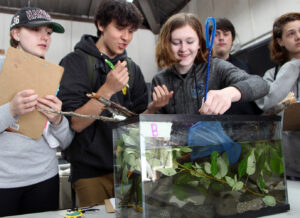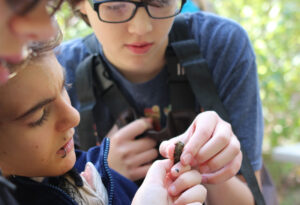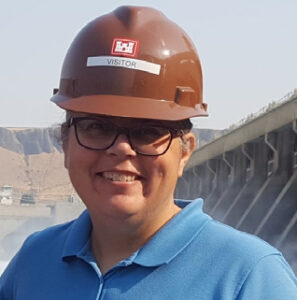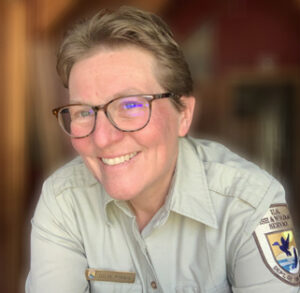Kids in the Creek is a north-central Washington State educational program supported by the U.S. Fish and Wildlife Service (USFWS). The program consists of a 3‑day educational field experience at Entiat National Fish Hatchery that brings students from local high schools together to interact with local waterways; learn about the environment; and discover the ways in which the various interests on the river, including irrigation, navigation, transportation, wildlife and habitat management, and hydropower generation, must be balanced in water resources management. In this interview, Rachel Little, the information and education coordinator for Benton Conservation District in south-central Washington and one of the original founders of Kids in the Creek; Amanda Newell, the education and outreach specialist at Cascadia Conservation District; and Julia Pinnix, the visitor services manager at the Leavenworth Fisheries Complex, tell us about the origins, development, and benefits of this important program.
Hydro Leader: Please tell us about your backgrounds and how you came to be in your current positions.
Rachel Little: I am the information and education coordinator for Benton Conservation District in south-central Washington. I am a fishery biologist by training, but I also pursued graduate studies in education. I love to talk to people about fish. Conservation districts are a form of local government agency that are found throughout the nation. The mission of a conservation district is to encourage wise stewardship of natural resources, including water, soil, air, plants, wildlife, and fish. I believe that wise stewardship of rivers includes both the use of hydropower as a clean, reliable, renewable generation source and fisheries management. New technologies, including improvements in turbine design and construction, have led to demonstrated improvements in both juvenile fish passage survival and generation efficiency at Ice Harbor Dam on the lower Snake River. My first professional role after graduating from the University of Washington was at Leavenworth National Fish Hatchery, Washington, where the Kids in the Creek program started.
Amanda Newell: I’m the education and outreach specialist at Cascadia Conservation District and have been there 11 years as of this fall. I have a bachelor’s degree in communications from San Diego State University. Right after college, I worked in the travel industry for several years; this is my first real job in the conservation world. However, my mom managed a conservation district on the west side of Washington State for about 10 years while I was in high school and college, and I would work there on breaks, so I was exposed to the work of conservation districts at an early age. Having a biologist for a mother, I have always had a great love for the natural world.

Julia Pinnix: I arrived at Leavenworth in 2015 and started helping out with the Kids in the Creek program. My role was visitor services manager for the Leavenworth Fisheries Complex. The complex includes three fish hatcheries, which are located in Leavenworth, Entiat, and Winthrop, and the Mid-Columbia Fish and Wildlife Conservation Office, which is based in Leavenworth. My dad was a park ranger, and I was born when he was working at Mount Rainier National Park. I lived across the country in different national parks before he switched to being a congressional aide. He helped to do things like put together the legislation for the Alpine Lakes Wilderness Area next to Leavenworth. I have a degree in environmental education from the Huxley College of Environmental Studies in Bellingham, Washington. I’ve worked for the National Park Service, the USFWS, the U.S. Forest Service (USFS), and private companies and nonprofits for more than 30 years.
Hydro Leader: How did the program originate?
Rachel Little: I’m proud to have been there in the beginning. I was a young fishery biologist at the USFWS when the Adopt-A-Stream Foundation approached us about doing an adopt-a-stream volunteer training at the Leavenworth Hatchery in 1991. The Adopt-A-Stream Foundation is a nonprofit group that recruits and trains citizen volunteers to monitor waterways, protect water quality, and develop riparian projects. When the foundation came to Leavenworth to develop this training, it already had a training template that included components such as how to do a fish survey; how to take water quality samples; and how to collect, sample, and identify aquatic insects and use them as indicators of water quality. I was glad to help with that volunteer effort, and it was a success with adults, but it struck me that it would work for students, too. That idea was the seed for the Kids in the Creek program.
I reached out to partner agencies, including the USFWS; the USFS; and the Chelan County Conservation District, which became the Cascadia Conservation District in 2007, and we developed a team so that these different modules could be taught by area experts. I taught the fish habitat section, a USFS hydrologist demonstrated how to take stream measurements, and some soil scientists from the Chelan County Conservation District and the Natural Resources Conservation Service took part as well. We decided to hold this field event at the hatchery. The hatchery at Leavenworth has 160 acres to protect its water rights, and there was a bypass channel that had water control at the head and lower ends so that flow could be controlled to keep the students safe. Being a hatchery, we also had lots of chest waders for students to wear. Just pulling on chest waders for the first time was a learning experience for some students. We wrote a curriculum to accompany the field event to make sure it was a really strong learning experience. The curriculum drew upon each of the field segments of fish habitat, stream and flow measurements, and soil types and asked students to use that data to inform the recommendations they made in response to a hypothetical question about land use at the site. This culminating land use simulation for students is a simplified model of what hydropower developers have to do: collect field data and design a defensible project that meets various social and environmental needs.
Hydro Leader: How has the program evolved from those beginnings?
Julia Pinnix: I observed the program in 2015 and started getting involved in 2016. There were a couple of things that I saw that differed from how the program had been run in the past. The biggest change we’ve seen is that the school day in our area has been reduced by about an hour and a half. The amount of time we had to spend with kids was reduced to the point at which we felt like there were elements of the program that weren’t functioning anymore. That was really frustrating.
The other thing is that spring meltwater runoff has been happening earlier and earlier. We were reduced to having kids in the mud instead of kids in the creek because it wasn’t safe to get anywhere near the river. Springtime was becoming really problematic. In response, a few years ago, we moved the program from the spring to the fall. While the weather in the fall season can be trickier, there weren’t any dangerous high-water levels like those we were consistently seeing in the spring.
The other change we made was with a summative activity called Watershed Wonders, in which the kids take all the work they have done in the field and think about it. That’s a really important part of the program, but we didn’t have enough time to do it during the shorter school day. We had been trying to smash it into 20 minutes, and it just wasn’t working. Instead, we decided to dedicate the entire day to field activities and then go into the classrooms afterward, sometimes up to 2 months later, and do the summative activity then. We’ve been impressed by how well kids retain the information they have learned in the field.
Amanda Newell: Some of the partners have stayed the same from the time when Rachel was here, and we have some new ones as well. When I came on in 2011, the core team planning the event included one member each from Cascadia Conservation District, USFWS’s Leavenworth National Fish Hatchery, and the USFS. In 2011, the team was in the end stages of creating a standalone website for the program. They also created a round of training videos for each of the stations. We’ve been able to use those videos and all the great resources on the website since then. In 2020, we produced some virtual materials and videos, since we weren’t able to host the in-person event.
Julia Pinnix: Of course, one of the big challenges we faced during the COVID‑19 pandemic was that we couldn’t do in-field biology. However, there was still a lot of interest from many of our teachers, who wanted to make the program available to their students in some form. We had the idea of creating videos and putting them on the website, but the teachers wanted materials as soon as possible. We thought about what we could put online quickly that would still be meaningful. We didn’t want to record a lecture, because that’s not a good educational experience. We wanted it to still be as hands-on as we could make it.
One of the programs we found the easiest to adapt was the one on macroinvertebrates. Identifying the aquatic macroinvertebrates—insects and other organisms—that you can see without a microscope gives you a measure of water quality. It can help you figure out the health of your stream without having to do chemical tests. Our idea was to get some video footage of a number of these different organisms and then have kids use online keys to figure out which organisms they were looking at and what the health of the stream might be. We were able to put that video together with a significant effort. I had to learn how to make videos, for starters. I went out to Entiat National Fish Hatchery and took a lot of footage, using a little magnifying device that clips onto my cell phone. We got good reviews from the teachers, so we know that the product works. Now it can just be used by anyone anywhere, and we’ve got plans to make more videos.

Amanda Newell: We also created virtual versions of the macroinvertebrate station, habitat station, and riparian station. I’ve been contacted by people from other parts of our state, neighboring states, and even New Zealand, asking if they can use our online materials. Of course, that’s what they’re there for. We love that the hard work that went into making these high-quality educational videos is benefiting people in different areas.
Usually, 30–35 resource professionals from over a dozen local agencies and groups help us throughout our 3‑day event, so it is a huge partnership effort. Career-connected learning is an important part of the program as well. The kids get to interact with actual resource professionals and use the tools and techniques that they would use in their daily work. That gives students an idea of the types of careers that are out there in conservation and natural resources. About 10 different schools usually participate in the program, including a mix of traditional and alternative high schools. Around 250 students total are involved every year. Students come from Chelan, Douglas, and Okanogan counties.
Hydro Leader: What kind of knowledge base do the student participants come into this program with, and what kind of results do you see?
Julia Pinnix: Some teachers, such as Joyce Block at Wenatchee High School, prepare their students thoroughly. They go over the material in advance of the program. Other students haven’t looked at any of this before. It can vary tremendously.
Amanda Newell: We also have pre- and postwork opportunities for teachers on our website.
Rachel Little: The program provides a lot of great field technique information. It’s exciting for students who may live in town and may never have waded into a creek before. That can be an influential experience. It’s great for secondary school students to meet natural resource experts in the field. It gives them an element of career education. While we don’t expect every student who takes part in this program to become a fish biologist or a stream hydrologist, they will all be natural resource consumers. They all will be using water, electricity, and oil and affecting plants and wildlife. Even if this Kids in the Creek experience doesn’t affect their career trajectories, I hope that it helps inform them about how natural resource agencies work and how we base policy on science and that it affects how they choose to live their lives and cast their votes. It’s important for students to see the connection between field science data collection and natural resource policy.
Amanda Newell: It’s a great way to expose students who might not spend much time in the natural world or who wouldn’t explore a creek with their families. There are always kids who don’t want to put on waders or touch the bugs at the beginning of the day. But by the end of the day, they’re sometimes the most engaged students. It’s rewarding to see that.
Julia Pinnix: A few years ago, we started a great work experience program in which students, in addition to their regular high school classes, also do conservation work. Kids in the Creek lasts for 3 days, and this group of students spent the first day doing all the activities that the regular students did. Over the next 2 days, they assisted at the different stations and helped teach other students what they had just learned the day before. They got a lot out of that program. These are not students who would typically be in honors biology or anything like that, but the experience changed how they viewed the importance of natural resources and the meaning of what they learned.
Hydro Leader: How does Kids in the Creek tie in with the hydropower world?
Rachel Little: The Kids in the Creek program helps students understand the process of collecting and analyzing field data and the importance of using field data to inform natural resource management. There are different stations within Kids in the Creek that have different focuses. I see that as being parallel to modern river management. You’ve got different silos of particular interest, including irrigation, navigation and barge transport, power generation, and salmon recovery with tribal and sport fisheries. In modern river management, we need to think about all those needs, similar to how students in the program have to assimilate the field data they collect at each station into the culminating activity and make recommendations on how best to manage the creek. Sometimes those river uses seem to be competing, but we’re hoping to broaden the students’ viewpoints by emphasizing that you have to take multiple factors into account to come up with a sustainable program that preserves the natural resources but also makes them usable by people.
Julia Pinnix: One of the things that has struck me while doing the summative activity for the Watershed Wonders program is what an eye opener it is for students to learn about water rights. They don’t know how water rights in the state work, and it’s an opportunity for us to teach them. It’s important for them to gain an understanding not only of the biological importance and value of the streams and rivers and lakes that we have, but also of how the law around them works.
Amanda Newell: In the Watershed Wonders activity, the kids use the knowledge gained from their field experience at Kids in the Creek to work through a land development proposal in a small group and then present their design to mock commissioners. The exercise gets students thinking about elements to be considered for land development and perspectives of different stakeholders that they wouldn’t learn elsewhere.
Rachel Little is the information and education coordinator for Benton Conservation District. She can be contacted at rachel-little@conservewa.net or (509) 736‑6000.

Amanda Newell is the education and outreach specialist at Cascadia Conservation District. She can be contacted at amandan@cascadiacd.org or (509) 436‑1601.

Julia Pinnix is the visitor services manager at Leavenworth Fisheries Complex. She can be contacted at julia_pinnix@fws.gov or (509) 393‑6507.

For more about Kids in the Creek, visit www.kidsinthecreek.com.

